Fine Vintage Hawaiian Girl Portrait Black Velvet Painting, CeCe Rodriguez 60s

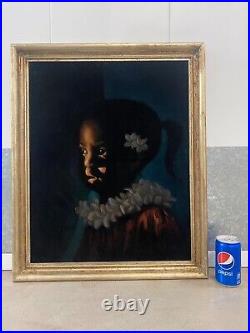

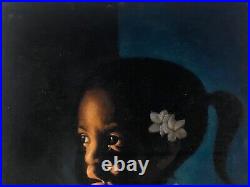
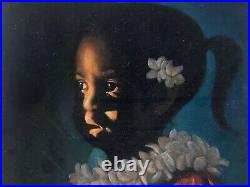


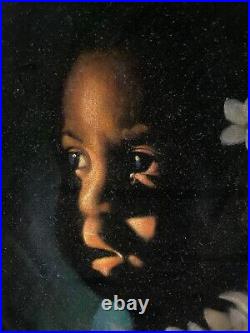



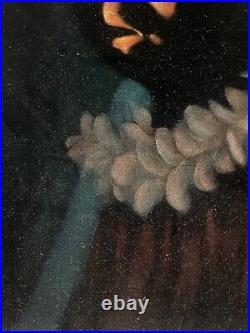




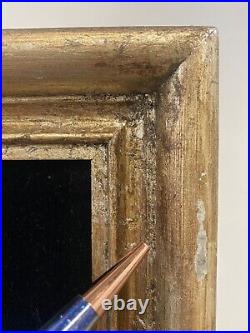




The is an important and Fine Vintage Hawaiian Girl Portrait Black Velvet Painting, Oil on Velvet, by renowned Hawaiian master velvet painter, Cecilia "CeCe" Rodriguez. This artwork depicts the somber portrait of a young Native Hawaiian girl, who wears a white flower in her hair and a delicately rendered white flower lei around her neck.
The girl stares outwardly, with a single tear drop rolling down her cheek. This artwork utilizes a chiaroscuro effect, with the scene being set in a dark room, and the girl's face being illuminated by a warm light off in the distance.
This artwork likely dates to the 1960's - 1970's. Approximately 18 3/4 x 22 3/4 inches including frame. Actual visible artwork is approximately 15 1/2 x 19 1/2 inches. Very good condition for age, with a light layer of dust over the painting please see photos.
CeCe Rodriguez is unanimously considered one of the masters of the South Pacific school of black velvet painting and is often compared with Edgar Leeteg and Tyree. Acquired from an old collection in Pasadena, California. If you like what you see, I encourage you to make an Offer.
Please check out my other listings for more wonderful and unique artworks! Five of her artworks are on permanent exhibition at the Velveteria: Museum of Velvet Paintings in Los Angeles, California. For years, several Hawaiian resorts proudly featured her work. As I flip through the book. I embark on an emotional roller coaster, awed by the beauty of the work of Charles McPhee, Edgar Leeteg, Burke Tyree and Cecilia Rodriguez --all masters of the human form regardless of media--and horrified and amused by the ineptitude and kitschiness of the various visages of Hulk Hogan and Jesus and Liberace. The authors of the book are a couple who knew they were soulmates when they admitted their mutual adoration for black velvet artistry and began to obsessively collect same. Eventually they opened the Velveteria Museum in Portland, Oregon closed as of 2010, alas, but looking for a new home supposedly; UPDATE: it recently reopened in L.To house and display their hoard and to obstensibly bring a modicum of respectability to a much-derided art form. This book culls its images from the best (and worst) of that collection, and also provides one of the few extant text histories of both the craft and industrial history of this maligned genre. Black velvet painting began in the 1930s when traveling American, Edgar Leeteg, began painting the lovely (and usually nude) ladies of the South Seas on velvet canvases and an impressed art dealer began to distribute the paintings. It eventually grew to big business in the'60s,'70s and 80s' with the opening of Mexican sweatshops churning out crude black velvet paintings of Elvis, Jesus, card-playing dogs, crying clowns, leopards and unicorns for cheap sale at McCrory's. Some artists, such as Rodriguez, fled from the business feeling that their art was being downgraded by the flood of chintz.
One story in this book relates how the authors found a stash of velvets at a carpet store, where the owner was more than glad to get rid of them, referring to them as his hall of shame. Carl Baldwin and Caren Anderson clearly see no shame in black velvet art, even having amused affection for the worst the form has to offer.
Looking through this book, it is evident to me that there are indeed black velvet masterpieces, though the masterpiece-to-junk ratio is indeed a wide one. For every stunning McPhee Polynesian nude or Rodriguez ethnic portrait there are hundreds of questionably charming images of John Wayne, Elvis, Marshall Applewhite (the Heaven's Gate cult leader), Hulk Hogan, Dolemite, Kenny Rogers, Martin Luther King Jr. Muhammad Ali, Oprah, Jesus, George W. Bush, Charles Bronson, Barbi Benton, Tempest Storm, Satan, JFK, Princess Diana, Bruce Lee, Che, Dali, James Dean, Marilyn, James Brown, Liberace and even Dr.
Margaret Keane's famous kitsch paintings of big-eyed children in the'60s (a favorite of my grandmother, as I recall) were copied by anonymous black velvet painters and made their way into unlikely subjects, including a series of mass-produced circular canvases of Vietnam soldiers with big heads and eyes and small bodies, teary eyed amid the chaos of war. They were bought as souvenirs by the troops and sent back home to families with personal messages written on a blank area of the canvas. There are some amazing things here; Burke Tyree's photorealist painting of a dwarf lemur on page 93, a remarkable copycat of Rembrandt's "Young Woman at a Half-Open Door" by an anonymous artist, and Cece Rodriguez's soul-catching portraits of traditional ethnic peoples.There's also the cringe-inducing stuff: big eyed children using the toilet, Jesus bestowing his blessing over a semi ("God Bless Our Truckers") and the like. The book is sensibly broken into about 40 pages of historical and background text and then into "galleries" featuring the art thematically: Polynesian subjects, clowns, animals, big-eyed kids, nudes, war, western, Jesus and Mary, black power, devils, black light, and so on. The book's cover, appropriately, is covered in actual black velvet. Sadly, the Velveteria's painting of a jackalope riding a unicorn is not in the book. However, it can be seen in this marvelous and funny profile broadcast in 2006 on CBS Sunday Morning, as reported by Bill Geist.
Black Velvet, If You Please. The phrase "velvet painting" brings to mind crying clowns and softcore tropical nudes, stacked unceremoniously in thrift shops or flea markets.
Among these you're unlikely to find a valuable Edgar Leeteg, the only velvet artist to achieve any degree of name recognition; but you may happen upon a neglected gem by one of four Canadian women-Minn Sjolseth-Carter, Dorothy Francis, May Clarke, Joy Caros-who painted prolifically, pragmatically and obscurely, on velvet. Over the next two decades I've acquired three dozen velvet paintings, including a "Velvis" that I religiously lint brush, an unsigned, slightly crooked, crown-of-thorns Jesus haggled from a Winnipeg antiques shop, and a narrow assemblage of blue flowers on black velvet, with a typewritten inscription on pink card stock: VI Waddington, Winnipeg. I feel object empathy for the paint-by-numbers kit paintings made by women artists like Waddington, a feeling as irrational as my affection for unattributed velvet paintings made in assembly-line factories. I rescue their velvety floral arrangements, consigned, as the unwanted craft projects of amateurs and hobbyists, to online classifieds, cobwebbed attics, garage sales. I trace the origins of my velvet hoarding tendencies to a fire that gutted my family home when I was twelve.
I learned that the only safe attachment to possessions comes with things that are cheap, laughable, easily replaced. Sjolseth-Carter closed the gallery in 1967, quitting velvet and committing herself exclusively to other media. After her death, much of her substantial body of work was accessioned by museums and galleries, but not one of her velvets.
In March 2020 I spotted a Dorothy Francis (1923-2016) painting on Craigslist and drove out to New Westminster to meet the owner. I parked illegally in the cul-de-sac of a high-rise condo development.
Wearing surgical gloves and a cloth mask, I handed twenty-five dollars to an older gentleman, who wore a mask but no gloves. He handed me a 20" x 27" portrait of an elderly Asian man brushed into soft brown velvet, an offensively hackneyed piece that I was both excited and ashamed to get my hands on. At home, I emailed Francis's son, the visual artist Tim Francis, who wrote, Part of mom's motivation to paint on velvet was doing portraits because she thought they could be compelling. The other part was likely financial. With five young children I know my father pushed her to produce work that would sell. Five years after her death, Francis remains only known for her watercolours, pastels and acrylics on paper and canvas. In late March 2020, unemployed and bored as a result of the pandemic, I decided to track down Joy Caros b. 1932, the indisputable queen of velvet painting. With little sentimentality she described her early years as an artist in Vancouver. She experimented first with difficult-to-handle chalk on velvet. She plied her trade painting portraits for tourists in Stanley Park, and for customers at Trader Vic's Polynesian-themed restaurant in Coal Harbour. Vancouver's Jewish community provided her a stable source of lucrative commissions throughout the 1950s. Davis represented Leeteg, whom he marketed as the Gauguin of American velvet painting.He hired Caros to surreptitiously retouch Leeteg paintings for sale. He commissioned a dozen portraits of the cast of his 1963 film. It's a Mad, Mad, Mad, Mad World.
Flying her out to Hollywood. Back home in 1964, Caros painted the Beatles on velvet. Caros left Canada and spent more than thirty years in Italy. She continued to pursue sales through exhibits at hotels in Europe and North America. In the late 1990s, she left behind velvet as a canvas. Family portraits commissioned by the visually impaired singer Andrea Bocelli were her last velvet works. During our conversation, Caros said Europeans respect velvet more than Americans do. Yet she also talked animatedly about licensing her work for pillowcases and candy wrappers. She stated, I don't miss velvet. There is no market for it. I don't think about it. Caros came across as dismissive of her velvet work, but fiercely proud of her technique. Able to produce one painting a week, Caros would stretch velvet over hardboard, sketch an outline with chalk or pastel and dry-brush oil paint with pig-hair brushes. A technique, she boasted, few artists can manage." She regaled how a visitor to one of her shows in Italy snipped off a piece of the velvet, believing that "the secret was in the velvet. In April 2020, I stumbled upon the work of the velvet artist May Clarke (date of birth and death unknown) of Ontario. I was able to locate one original May Clarke, acquired by a woman in Ontario from a thrift store: a portrait of a sultry, exoticized woman, with a blank expression, hooded in lace.
It was a technically competent, if unoriginal, composition that evoked the uncanny valley, as unnerving as the big eyes of a Margaret Keane painting, whose work recently experienced a resurgence after Tim Burton made a biopic about her called. Even a fan such as myself has to acknowledge velvet paintings as aesthetically disturbing and problematic as artifacts of appropriation and cringeworthy stereotypes. The walls were decorated salon-style with her oil-on-canvas paintings.She showed me some of the velvets in her private collection, unframed for storage. The fabric, a black rayon cotton velvet, with upright hairs that do not flatten when pressed with paint, she said, came from a wholesaler in New York.
She turned the edges of the fabric, revealing a patterned design that can help differentiate authentic from fake. She then held the loose fabric up to the light. With a true Caros painting, she explained, you can see the light through.
" She added with glee, "You could run it through the washing machine! I asked if she knew Dorothy, Minn or May. Caros answered with a defiant, Nobody can copy me. Joy Caros and that's all. Before I left, Caros expressed hope that a retrospective exhibition could be held for her before she passes. In September 2020, I chatted with Caren Anderson, former co-owner of the Velveteria Museum in Los Angeles, which shuttered in 2019. She told me about the self-taught American velvet painter Cecelia "CeCe" Rodriguez, still painting in Las Vegas at the age of 101, though no longer on velvet. Anderson lamented that velvet painting was another thing men had claimed for themselves. " I think about women like Rodriguez, Caros, Clarke, Sjolseth-Carter, Francis, whose names and work are invisible to "high art critics, curators and collectors, even to those who champion outsider and kitsch art.Women whose work stamped a female gaze onto the ubiquitous exoticized bodies of velvet painting. I worry for the few remaining elder stateswomen of velvet painting, like Caros and Rodriguez.
I look forward to celebrating the end of the pandemic with a sickly sweet cocktail at the Waldorf Hotel in Vancouver, the walls of its historic Tiki Bar adorned with Leetegs.